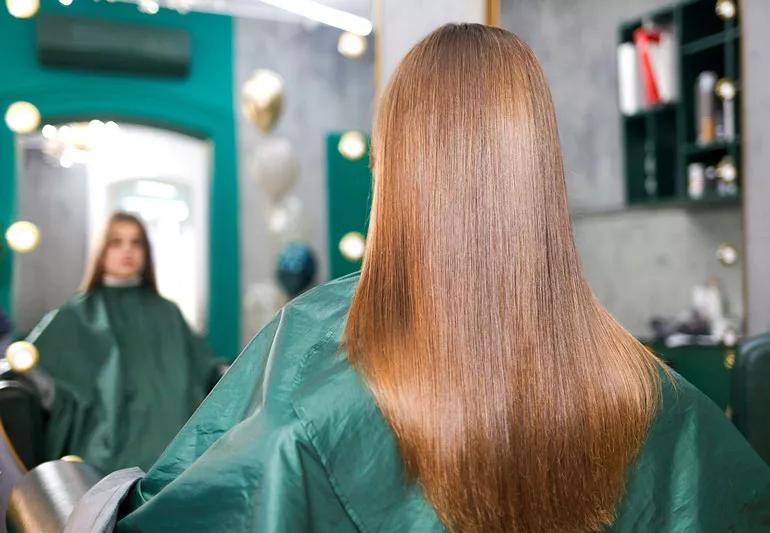The popular salon service aims to give you smooth, shiny, frizz-free hair

For those who lust after having smooth, frizz-free hair, you may have heard of keratin treatments — and maybe you’ve even tried the popular salon service.
Advertisement
Cleveland Clinic is a non-profit academic medical center. Advertising on our site helps support our mission. We do not endorse non-Cleveland Clinic products or services. Policy
A keratin treatment can reduce your blow-drying time, cut down on frizz, smooth your hair cuticle and amp up shine. But for some individuals, keratin treatments may damage your curl pattern and it can be an expensive and lengthy process.
Dermatologist Alok Vij, MD, explains what’s involved with a keratin treatment and if it’s something you should try.
Keratin is a type of protein that makes up the outer surface of your hair, skin and nails.
“As you age, you lose keratin. It gets broken down or becomes damaged,” explains Dr. Vij. “Overtime, factors like environmental triggers, UV chemicals and heat can break down keratin. Those factors basically cause the protein to change its natural shape.”
And as the shape and structure of keratin change, its function changes. “That means that your hair doesn’t have the same strength, elasticity or shine,” he continues.
That’s where a keratin hair treatment comes in. “Keratin treatments are a chemical process where the outer layer of the hair shaft is smoothed,” says Dr. Vij.
Keratin treatments can be used on any hair type. “People typically with longer hair or curly, frizzy hair may be more likely to use it,” he notes. “But even if you have short hair and you’re not happy with your hair’s volume, you can use the keratin treatment to make your hair look a little bit fuller and more lustrous.”
Advertisement
The process can vary at different salons, but typically, a hairstylist will start off by washing your hair twice with a clarifying shampoo.
After that, a keratin treatment or solution is applied to your wet hair and combed through. The solution will sit on your hair anywhere between two and four hours, depending on the amount of hair you have and its texture.
Finally, your hair stylist will dry your hair and then use a flat iron to seal the treatment into your hair. This step is key.
“The keratin treatment isn’t shampooed out. It coats your hair and it smooths everything out,” explains Dr. Vij. “And then the heat seals it, or cures it, to help restore that outer layer to a glossy, shiny, smooth texture.”
A keratin treatment before and after may surprise you with how sleek and shiny your hair is. And those results can last about six months if you don’t wash your hair too frequently.
Some pro tips? You want to wait a few days before your first shampoo after your keratin treatment and then try to cut down on the number of times you shampoo. And use sodium chloride-free hair products, which are free of harsh chemicals that can harm your hair.
Some keratin treatment formulas may contain formaldehyde, a strong-smelling chemical that can cause watery eyes, coughing, wheezing, skin irritation and a burning sensation in your eyes, nose and throat.
“Unfortunately, formaldehyde is in almost everything around us. It’s in soaps, shampoos and the foods that we eat,” says Dr. Vij. “Obviously, you don’t want to be putting that into your body in high quantities. So, if you can avoid exposure to formaldehyde, it can be helpful to maintain skin health and overall health. There are still questions about whether there are links to cancers and other negative effects on our overall health.”
While there are formaldehyde-free keratin treatments on the market, those formulas don’t work as well. So, make sure you do your research and weigh the pros and cons of a keratin treatment.
Keratin treatments aren’t recommended for individuals who are pregnant. And if you have sensitive skin or allergic contact dermatitis, you want to proceed with caution.
“Those individuals should just be careful,” stresses Dr. Vij. “You want to look for formulas that may be fragrance-free and preservative-free.”
You may also want to consider the cost of a keratin treatment. You can spend upwards of $300 per treatment.
At-home keratin treatment kits are available in stores and online that might work better for your budget. But it’s vital that you read through all the instructions beforehand and follow them closely.
Advertisement
“Make sure you clean your hair well with a nice shampoo. Apply the keratin treatment, let it soak in and then activate it with a heat source,” says Dr. Vij. “Professional heat sources may be more effective over a shorter amount of time.”
Advertisement
Learn more about our editorial process.
Advertisement

Your immune system may attack hair follicles anywhere on your body

Focus on nutrition, gentle styling habits and adapting to your hair type

It’s normal to lose around 50 to 150 strands per day to routine hair shedding

How often you lather up your locks can depend on various factors, like hair type, age and ethnicity

Eating whole grains, salmon, fruits and vegetables can help you achieve longer, healthier locks

Studies are mixed, but frequently wearing very tight, warm hats could stress your follicles and lead to hair loss

Things like stress, heated styling and other health conditions may cause you to lose more hair than normal

Use products that reduce inflammation without causing irritation and avoid fragrances, dyes and exfoliators

If you’re feeling short of breath, sleep can be tough — propping yourself up or sleeping on your side may help

If you fear the unknown or find yourself needing reassurance often, you may identify with this attachment style

If you’re looking to boost your gut health, it’s better to get fiber from whole foods